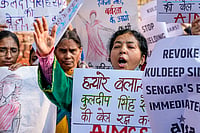On Guard...
- Many Indians report reactions to drugs every year—yet very little action is taken
- India tends to rely on adverse reactions reported overseas, though the impact of drugs varies with genetics, diet etc
- Every year, around 300 new drugs are introduced in India
- Drugs are banned off and on, but being rarely backed by large studies, bans have little impact
- Now, by doing large studies of drug reactions, rare reactions should come to light. Spurious and low-quality drugs could also get unearthed.
***
Many years ago, Monica Bhowmick, a Mumbai resident, discovered the hard way that she was intolerant to drugs containing sulpha, or sulphonamide, among the oldest synthetic antibiotic groups and a common constituent of painkillers. A dentist she was visiting, she recalls, may have recommended the medicine. “I suddenly broke into a tremendous rash,” she says. The eruption vanished when Monica took an anti-allergic pill. Since then, she has been careful not to take sulpha-containing drugs.
Till now, it was mostly patients themselves who kept track of any drug intolerance they might have—for their own safety. But now, doctors, hospitals and even the government are tracking thousands of unexpected responses to drugs in the hope of discovering patterns in how Indian patients react to medicines. Since September last year, the government has invited private and government hospitals to collaborate, and 22 centres across the country, each manned by two people—including a technical analyst—are now active in collecting reports of drug reactions. These centres, located in hospitals around the country, are linked to the WHO’s pharmaco-vigilance programme, headquartered in Uppsala, Sweden.
Two earlier programmes to monitor the side-effects of medicines failed, as patients’ reports on reactions were collected but could not be analysed for lack of planning, manpower, finances and other issues. “This time we cannot fail. If we have such a programme, we would not have to depend on (records of) side-effects observed in other countries. We need our own data so that we can offer better care to Indian patients,” says Ranjit Roy Chaudhury, who runs the Delhi Society for Promotion of Rational Use of Drugs, and heads a new pharmaco-vigilance programme—as it is technically known—for Apollo Hospitals.
After the programme was launched, 1,300 cases have been recorded. This figure may appear small—from 2006 to 2008, 12,000 adverse drug reactions were recorded in India—but the number is likely to rise as healthcare improves. aiims is the institution to which the centres send weekly drug-reaction reports. These are collated and forwarded to the Drug Controller General of India (DCGI).
A large hospital with 500 beds can easily expect four or five adverse reactions a week. Some of these are predictable side-effects, or events doctors and pharmaceutical companies expect, for they are listed on the package as a warning. “It’s the reactions that aren’t listed, usually very rare, that pharmaco-vigilance hopes to uncover,” says D.G. Shah, secretary general of the Indian Pharmaceutical Alliance (IPA). Adds Ranjit Shahani, country president of Novartis, “It’s important because drugs could behave differently in different patient populations, based on, for instance, genetics, ethnicity and diet.”
Of course, key issues remain. Unless patients report a reaction and find that action is taken—say, a new drug interaction or contraindication is recorded, new warning labels put up, or drugs withdrawn—no one will know whether the programme is working effectively or not. There are some who think doctors need incentives for taking on the additional burden of reporting unusual reactions. “At 100 or 150 patients a day or more, one can safely say that many doctors are already quite busy,” warns Dr Sangeeta Sharma, professor of pharmacology at Delhi University.
At present, drug manufacturers must report adverse reactions to the DCGI for two years after introducing a medicine, followed by bi-annual reports for three years. Thereafter, reactions have to be reported as they occur. Yet, it is unheard-of for a medicine to be recalled based on adverse events reported from India—because the rules are not stringently applied and the system is not user-friendly. “Reporting requires pen and paper, and posting results somewhere. Indian patients rarely know if the reactions they experience are to be expected or something unusual. It’s also a struggle to set up a working hierarchy, such as the regional centres now being envisaged. Anyway, it’s timely,” says Sharma.
Uncovering the rare or uncommon response—the stated goal of pharmaco-vigilance—requires hundreds of thousands of people using a medicine to report unknown side-effects often enough. For example, take the adverse impact caused by oral contraceptives, which have been around for decades, on cardiac function, discovered lately in the UK. Such undetected side-effects usually take years to collate. Ironically, some of these data-collection and collating skills already exist in India’s healthcare outsourcing industry, with companies such as tcs and Accenture providing pharmaco-vigilance to US or European pharmaceutical companies.
“As Indian generic companies forge marketing alliances with global companies to sell Indian-made drugs, the need for reporting will increase,” says Dr Chitra Lele, chief scientific officer, Sciformix, a company that offers off-shore support to large and mid-size pharma companies. Lele says that, at present, the volume of Indian data is negligible. “Indian companies either try to get adverse reports through their field force, or, of late, they provide a phone number to call with reports, but this is rare.” Contrast this with the US and EU, where reporting adverse drug reactions to the regulator is voluntary for healthcare professionals (doctors, nurses and pharmacists) and mandatory for pharmaceutical companies.
In another recent action, the Medical Council of India (MCI) plans to reactivate a pharmaco-vigilance programme in all medical colleges across India. Given the indiscriminate prescription of antibiotics and the large-scale prevalence of fake drugs in India, the medical system seems to be making up for two failed attempts—and that’s not a bad thing even if it is 60 years late.


























